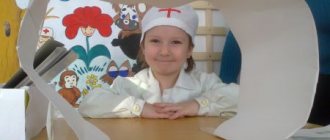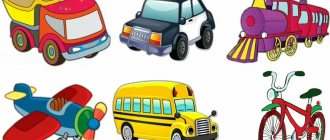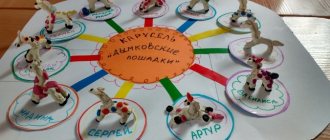Self-analysis of the teacher
This event was held on April 16, 2014 in the middle group. Children of middle preschool age. Most children have been attending the group since September 2013.
GCD had the character of a game, and was not the only one in the cycle of etiquette events. Before this, several events were held with the children, united by the theme “Etiquette”: “What is etiquette?”, “If you are polite”, “Table etiquette”, “Away etiquette”, “School of etiquette. We came to the theater,” which were aimed at studying and mastering the rules of behavior in society.
"ETIQUETTE LESSONS"
- the final one in a series of events this academic year.
Program content:
- learn to find the right solutions in various problem situations;
- improve the culture of dialogical speech: listen to the interlocutor, answer questions in complete sentences and phrases;
- practice using polite words;
- cultivate a culture of communication and a culture of behavior;
- develop mental activity in children.
Preliminary work:
memorizing poems about etiquette and polite words.
The lesson is structured in three stages: motivational, meaningful, reflective.
Motivation came from the problem posed: how to help friends get by without quarreling.
Reflective stage: summing up, drawing hearts with sparkles of kindness.
The following technologies were used in GCD: health-saving, gaming, ICT, collaboration technology, and a person-oriented approach.
All requirements for GCD etiquette were met:
— Motivational support: attract one or another external motive that gives the correct way of action a certain value (imitate peers, earn the recognition of an adult, imitate a literary character).
— Aesthetic support: beauty, harmony in the selection of materials.
— Emotional support: an atmosphere of pleasant positive emotions; friendly attitude; sincerity; the teacher’s interest in the children’s success; own emotional manifestations of both children and adults.
— Form of organization: game-activities.
— Features of interaction with children: relying on their life experience; providing a clear, interesting motive for activities in the classroom and psychological support for children.
Overall, I think the event went well. The children participated in the game with interest, showed their good knowledge of the rules of etiquette and at the same time added new information to them.
Thus, we can say that the goal of the event was achieved, the children learned the basic requirements in behavior and communication with people, and mastered the skills of cultural behavior. We can only hope that they will use this knowledge in their lives.
teacher,
GBOU Lyceum No. 1367, preschool department No. 2,
Moscow, Russia
Open lesson on the surrounding world in the middle group “Animals of the middle zone”
Open lesson on the surrounding world in the middle group “Animals of the middle zone”
Lesson on the surrounding world in the middle group “Animals of the middle zone”
Formation of a holistic picture of the world
Topic: " Animals of the middle zone "
.
Objectives: To consolidate the idea of the wild animals of our forests: appearance, habits, nutritional characteristics, adaptation to living conditions. To consolidate knowledge of the names of baby animals, also in the plural.
Objectives: Develop speech and thinking. Cultivate interest and desire to learn more about wild animals.
Demonstration equipment: pictures of animals from the middle zone, illustrations from the “Guess Whose Tail”
, magnetic board, phonogram
of “magic music”
. Progress of the lesson: The teacher invites the children to go into the forest. Music sounds, the teacher says the words: How beautiful the Russian forest is. It is full - full of miracles!
What do you know about animals (they have 4 legs, a tail, and a body covered with hair)
.
The teacher offers to solve riddles and find out who lives in the fairy-tale forest.
Who walks around angry and hungry in the cold winter?
I walk around in a fluffy fur coat, I live in a dense forest. In the forest on an old oak tree I gnaw nuts
Fluffy tail, golden fur, lives in the forest, and steals chickens in the village.
A ball of fluff, a long ear, jumps smartly, loves carrots.
Under the pines, under the fir trees, lies a bag of needles.
Who, having forgotten his worries, Sleeps in his den?
After each guess, the teacher puts a picture of an animal on the board. Each animal has its own home.
Didactic game “Who lives where?”
Where does the bear live? ...in a den, a fox...in a hole, a hare...under a bush, a squirrel...in a hollow, and the wolf's house is called...a den.
Poem:
A fox in a deep forest has a hole - a safe home. Snowstorms in winter are not scary for a squirrel in a hollow near a spruce tree. Under the bushes, a prickly hedgehog rakes leaves into a pile. The clubfoot sleeps in the den, and he sucks his paw until spring. Everyone has their own home, everyone is warm and comfortable in it. It’s cozy for everyone, both mothers and their babies. Who creates comfort, what are these mothers' names?
What is the name of the fox's cub - (fox cub, (many-fox cubs, mother fox cub - fox. Bear cub - (bear cub, Mother bear cub - she-bear. Hedgehog cub - hedgehog, mother of the hedgehog - hedgehog, many - hedgehogs. Wolf cub - wolf cub, many wolf cubs, the wolf cub's mother is a she-wolf.
Each animal has its own character, its own characteristics and its own appearance. Yes, you probably know this well yourself.
Game exercise: “Name the signs
of animals ”
: Fox -
(cunning, red, fluffy)
.
Hare - (cowardly, long-eared, changes its coat in winter)
.
Bear - (brown, club-footed, clumsy, hibernates in winter)
.
Wolf - (angry, gray, toothy)
.
Hedgehog- (prickly)
.
Now tell me guys, can you say that about people? Angry like...a wolf. Cowardly like...a hare. Cunning like….a fox. Clubfoot like... a bear. Toothy like….a wolf. Jumping like... a squirrel.
Physical education: Let's relax together. Let's do "Animal exercise"
.
One - squat, two - jump. This is a rabbit exercise.
And when the fox cubs wake up, they like to stretch for a long time. Be sure to yawn and wag your tail.
And the wolf cubs arch their backs and jump slightly.
Well, the clubfoot bear has its paws spread wide: first one, then both together, marking time for a long time.
And for those who don’t have enough exercise, we start all over again.
Didactic game based on pictures: “Guess whose tail”
.
Name it: fox- (fox)
;
in a hare - (hare)
;
in a wolf - (wolfish)
;
in a bear - (bearish)
.
Questions: What fairy tales do you know where the main characters are animals? "Masha and the Bear"
,
“Fox with a rolling pin”
,
“Wolf and Fox”
,
“Zayushkina’s hut”
.
Who can tell me, guys, how wild animals differ from domestic ones? (wild animals live in the forest, and domestic animals live in houses where people take care of them). Wild animals have to fend for themselves and get their own food.
Let's feed the animals. Who will we give honey to? -to the bear. Carrot for the hare. A mushroom for a hedgehog, a fish for a fox, a nut for a squirrel. Meat for the wolf.
-Who were we talking about?
On the table in front of you is a picture to color. Who is depicted on it? Let's color the animals. See if you have chosen the right color for your animal?





